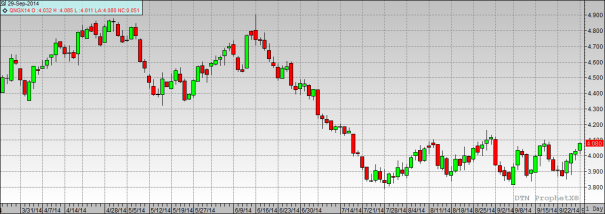09/29/2014 010:48 SNL: Market response to fall-weather foreshadows possible winter trouble, particularly in the Northeast.
Whether the market can weather the weather is the question that had natural gas futures moving both higher and lower through the week to Sept. 26. In a transition from summer to fall that was less than seamless, the market is eyeing the latest changes to natural gas storage and forecasts for the upcoming winter with uncertainty and caution.
As October options expired, a slightly larger-than-anticipated build to natural gas inventories of 97 Bcf, reported by the U.S. Energy Information Administration on Thursday, Sept. 25, for the week to Sept. 19, only inspired a brief turn to the downside as market participants turned the storage-inspired losses to short-covering gains, driven by the lingering concerns surrounding storage deficits and what weather events the upcoming fall shoulder season and winter heating season will bring.
In natural gas futures, “The weekly storage report engendered a brief sell-off but prices rebounded on expectations of a cold air trough making it down into the US from Canada in mid-October after all,” Kilduff Report publisher John Kilduff said. “There is a cold air mass in Northwestern Canada that is being closely watched, producing anxiety around the market as to whether or not it will impact demand, if it arrives,” Kilduff said in a Sept. 26 note to clients.
“It is almost like watching a spinning top, wondering if and when it will topple over. The price sensitivity to the weather outlook is elevated this time of year, due to the ability of conditions to be incredibly mild, hot, or very cold,” he said.
Natural gas futures spent much of the week to Sept. 26 on the uptick, advancing in the week’s opening session, slipping the following session, then posting gains on both Sept. 24 and Sept. 25 before ending the week on the modest uptick in positioning as the October contract rolled off the board at $3.984/MMBtu, up 1.3 cents on the day and up 14.7 cents on the week.
The November contract moved similarly higher, finding a $3.969/MMBtu to $4.040/MMBtu range before finishing the Sept. 26 trading day up 1.5 cents and above the psychologically important $4/MMBtu mark at $4.029/MMBtu.
“As has been the case over the past two months, the downside proved limited on the idea that prices below the $4.00 mark represent a relative bargain when it comes to valuation, and faith that winter heating demand will be enough to send the market higher,” Citi Futures analyst Tim Evans said.
“To a large extent we agree with that as an intermediate-term assessment. However, we continue to see risk that the large seasonal storage injections of the next few weeks could drive nearby futures to new lows for the cycle,” Evans said.
What will weather do
In terms of weather and its impact on storage, Chris Kostas, senior power and gas analyst at Energy Security Analysis Inc., said he expects natural gas inventories to reach a healthy level ahead of the winter. “Seasonally-soft demand from the power sector, negligible demand from the heating sector, and continued natural-gas production growth (particularly from the Marcellus region) should allow for further gains against the year-over-year storage deficit,” he said in a Weather Service International-ESAI joint forecast.
Further out, an El Nino is likely to keep the hurricane season quiet and could produce a warm but snowy winter across major cooling regions of the country, according to data from the National Weather Service.
As longer-range forecasts suggest the ongoing development of an El Nino for the winter 2014-2015, the Climate Prediction Center webpage that shows U.S. seasonal composites of temperature, precipitation and snowfall shows a tendency for snowier El Nino winters in the Mid-Atlantic and the Northeast.
Early cold provides glimpse to spot-market hot spots
While natural gas futures struggle to breach and hold above $4/MMBtu, amid the impending weather and the impact on natural gas storage on supply and demand expectations, day-ahead market volatility has been observed since the official end-of-summer and start of the fall shoulder season. Weather has been responsible for some price anomalies across the country in day-ahead gas trading that could act as a gauge to where challenges may lie for the upcoming winter season.


